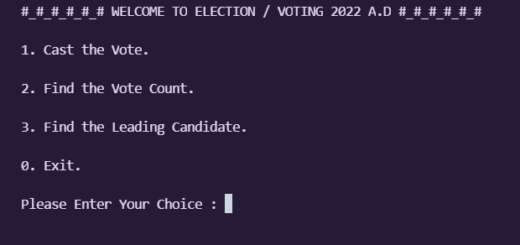EMI Calculator Mini Project using C program with Source Code
Introduction
The C programming language is a procedural programming language. Between 1969 and 1973, Dennis Ritchie worked on the project. It was created primarily as a system programming language for developing operating systems. Low-level memory access, a small collection of keywords, and a clean style are all qualities that make C language excellent for system programming, such as operating system or compiler development.
Why Learn C Programming Language?
Because it mixes the characteristics of high-level languages with the functionalism of assembly language, C is often referred to as a middle-level computer language. The manipulation of bits, bytes, and addresses in C gives the programmer more control over how the program will behave and more direct access to the underlying hardware mechanisms.
Working programmers influenced, influenced, and field-tested C. As a result, C provides the programmer with exactly what he or she want. C++ is a more advanced version of the C programming language. C++ incorporates all of the features of C, as well as support for object-oriented programming (OOP). Furthermore, C++ includes numerous enhancements and features that make it a “better C,” regardless of whether or not it is used for object-oriented programming.
EMI Calculator
An equated monthly installment (EMI) is a fixed monthly payment made by a borrower to a lender on a set day each month. Equated monthly installments are applied to both interest and principle each month, and the loan is paid off in full over a certain number of years. The borrower pays fixed periodic payments to the lender over several years to retire the loan in the most common forms of loans, such as real estate mortgages, vehicle loans, and school loans.
Variable payment plans, in which the borrower might pay higher sums at his or her discretion, are not the same as EMIs. Borrowers on EMI programs are usually only authorized to make one set payment per month.
Borrowers profit from an EMI since they know exactly how much money they’ll have to pay toward their loan each month, making personal budgeting easier. Lenders (or investors to whom the loan is sold) benefit from the loan interest since it provides a consistent and predictable income stream.
The following formula is used to determine the EMI:
(PR(1+R)T)/(((1+R)T)-1)
where, P is the principal amount borrowed,
T denotes the periodic monthly interest rate,
and T denotes the total number of years.
The best way to learn is to do. Hence, what better way to learn C programming language (if you know the basics) than to code your first mini project. In this tutorial we are going to build EMI calculator mini project using c programming language. Keep in mind this is a mini project for absolute beginners and intermediate programmers as well.
Source Code
This application will read the total loan amount, interest rate, and loan term in years before printing the monthly EMI for that loan amount. The formula for calculating the EMI in this program is (PR(1+R)T)/(((1+R)T)-1).
#include <stdio.h>
#include <stdlib.h>
#include <conio.h>
// for sleep() function
#include <math.h>
int main()
{
float principal, rate, time, emi;
printf("Enter the principal: ");
scanf("%f",&principal);
printf("Enter the rate: ");
scanf("%f",&rate);
printf("Enter the time in year: ");
scanf("%f",&time);
// one month interest
rate=rate/(12*100);
// one month period
time=time*12;
emi= (principal*rate*pow(1+rate,time))/(pow(1+rate,time)-1);
printf("The Monthly EMI is = %f\n",emi);
return 0;
}Output



